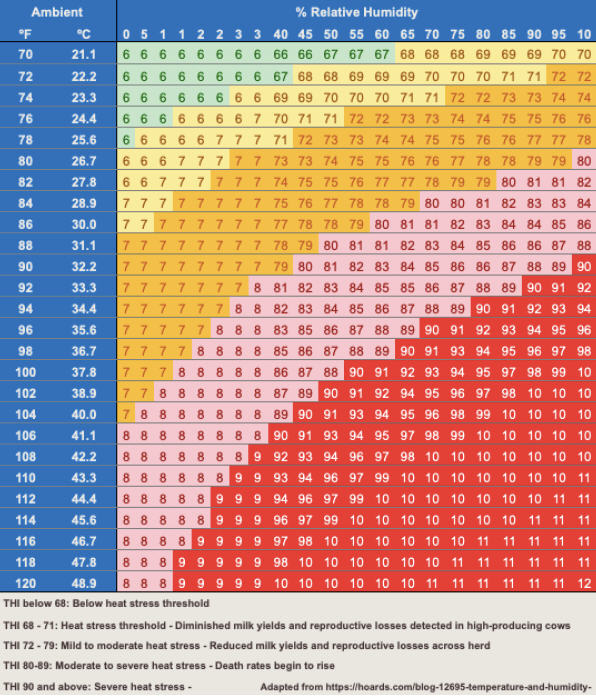INTRO TO FAT FEEDING DURING HEAT STRESS
Posted by Richard Shepardson, M.S. and Matthew Sellers, Ph.D on Jun 16, 2020 9:40:55 AM
Implementing strategic fat feeding on dairy farms can help mitigate some of the economic losses caused by heat stress.
The US dairy industry suffers significant economic losses due to the negative effects of heat stress on cattle every year. Heat stress decreases dry matter intake, leading to lower milk yield and increased risk for conditions such as lower body condition scores, rumen acidosis, and milk fat depression. Increasing ration contents of fermentable carbohydrates can exacerbate acidosis. Today, the best way to handle heat stress is through fat feeding.
Fat is a non-fermentable nutrient, and saturated fatty acids (FA) do not decrease dry matter intake, negatively impact rumen fermentation or contribute to altered biohydrogenation pathways. Feeding fat can increase nutrient density of the ration to improve energy consumption, especially when intake is lower during heat stress. Implementing strategic fat feeding on dairy farms can help mitigate some of the economic losses caused by heat stress.
TEMPERATURE-HUMIDITY INDEX
Each year in the United States, dairy farmers suffer large economic losses attributed to heat stress that have been estimated to be somewhere between $900 million and $1.5 billion (Donnelly, 2012). Although farms in the southern states feel this impact more profoundly and for a longer portion of the year, farms in the northern parts of the country deal with heat stress during summer months as well. Dairy cows are most comfortable when they are in their thermal neutral zone (TNZ), which is range of temperatures where cows are not expending energy to either stay cool or keep warm. The 1981 NRC reported the TNZ for dairy cows as somewhere in the range of 55° - 65°F (NRC 1981).
Recently, we’ve learned that while ambient temperature plays a large part in determining degree of heat stress, relative humidity is equally important, as cows are much less adept at using evaporative heat loss (e.g. panting, sweating) when relative humidity is high. Ambient temperature and relative humidity can be combined into a single measure known as the Temperature-Humidity Index (THI) that gives a single-variable estimate of degree of heat stress. The formula for THI is shown in Figure 1. The inter-relationship between ambient temperature and relative humidity is demonstrated in Figure 2, which lists THI for various combinations of ambient temperature and relative humidity, as well as some classifications of severity of heat stress. There are several management strategies such as keeping cows in shade, offering misters to keep animals cool, and offering fresh feed and water that can all help mitigate some heat stress for dairy cows but cannot completely eliminate it.
Figure 1. Temperature-Humidity Index and associated levels of heat stress.

Figure 2. Calculation of Temperature-Humidity Index (THI)

HEAT STRESS IN DAIRY COWS
Many of the effects of heat stress in dairy cattle were reviewed by Conte et al. (2018). Briefly, cattle experiencing heat stress undergo a number of physiological changes. One of the most noticeable is the changes in dry matter intake and milk yield. Cows in heat stress have higher maintenance energy requirements, shifting energy away from milk yield. The decrease in dry matter intake is attributed to multiple factors including shifts in rumen kinetics and gut motility as well as a heat abatement strategy, as fermentation in the rumen is an exothermic (heat-creating) process.
Decreased feed intake is an issue for many reasons:
- The first is that feed intake is associated with water intake, and it is more difficult for cows to maintain cooler body temperatures without adequate water.
- Secondly, intakes of fiber stimulate rumination which leads to more salivary buffering capacity in the rumen. Cows also alter feeding behavior during times of heat stress which may lead to “slug feeding”. Therefore, cows with lower intakes may be at higher risk for rumen acidosis.
- The final and most glaring issue is that lower dry matter intake typically means a decrease in nutrient intake, meaning cows have less energy for body maintenance, lactation, and reproduction.
As dry matter intake deceases with heat stress, farmers and nutritionists are forced to alter their nutrient strategies in rations. To increase the amount of energy cows are consuming on less intake, nutritionists can decrease the fiber content and increase the concentrate ingredients. However, many concentrate ingredients, such as corn grain or sugar sources, are high in fermentable carbohydrates. Fermentation is an exothermic reaction, so cows consuming large amounts of concentrates may not be able to cool themselves as effectively as cows that are consuming less rapidly fermentable feeds. Additionally, adding a large amount of fermentable carbohydrates to a ration while decreasing fiber also increases risk of acidosis. Acidosis can lead to milk fat depression and other factors detrimental to a profitable lactation.
SATURATED FATTY ACIDS
Fat is the most energy dense nutrient available and can increase the energy value of a TMR without taking up much space in the ration. Fat does not ferment so it does not contribute to heat generation in the rumen. However, adding large amounts of unsaturated FA from sources such as oilseeds or liquid animal and vegetable fats can negatively impact the rumen, leading to decreased fiber digestibility and increased risk for diet-induced milk fat depression. Saturated FA are a “safer” method of adding fat into the ration, especially in larger amounts, as they do not inhibit fiber digestion and do not increase risk for milk fat depression.
Learn more about fat feeding during heat stress.
Download the full white paper.
Learn more about the Energy Booster product line. And reach out to the technical experts at Milk Specialties Animal Nutrition for more information or to ask a question.
Topics: ANIMAL NUTRITION

